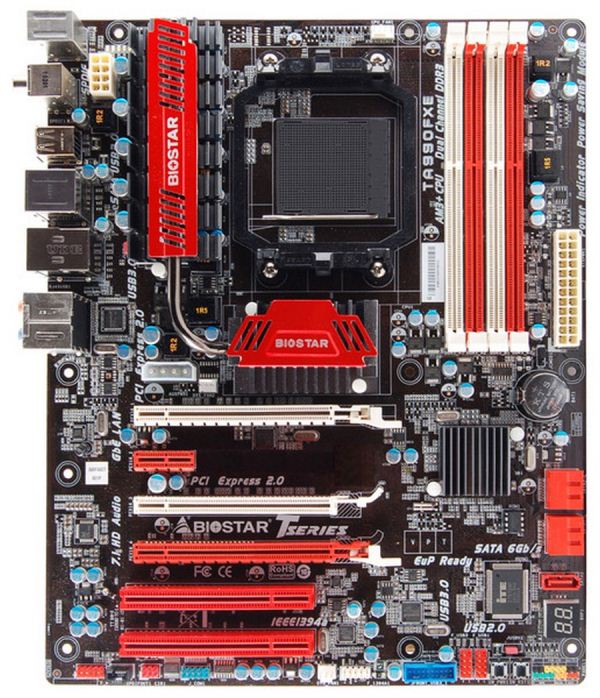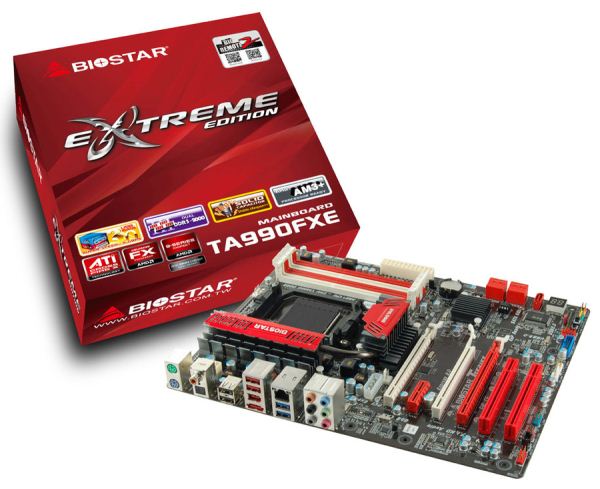990FX Motherboard Roundup with Thuban and Bulldozer – A Second Wind for ASUS, Gigabyte, MSI and Biostar
by Ian Cutress on April 5, 2012 11:00 AM ESTBiostar TA990FXE
Coming in at the cheapest 990FX board of this roundup, we have AnandTech’s first Biostar board in almost a year and a half. To me, as an enthusiast, when I hear the name ‘Biostar’, certain adjectives come to mind – the most prominent of which is ‘inexpensive’. As a home system builder and enthusiast, I have come across Biostar offerings when looking at motherboards online, and they are usually quite cheap. At those prices, I always think there is a catch – either the design may not be the best, or perhaps the warranty or support could be a dodo. I plan to cover more of Biostar's boards in the future, so from here on out I plan to put all the prejudice aside and concentrate on what matters – does it do what it says on the tin, would home users want it, and is it worth the money?
Overview
$130 is not a lot for a motherboard in the 990FX space. It comes in at the cheapest board in this multi-board review, and judging on an overview of the results and features, people might be inclined to agree.
The PCIe layout, for example, is not well thought out - the manual contradicts the layout of the board by stating that the full-length PCIe slots 1 and 3 are the primary GPU outputs, but in reality, dual GPUs should be placed in full-length PCIe slots 1 and 2. SATA ports are split between the main ones and eSATA, leaving five internal SATA ports rather than using another controller. The LAN port is non-standard as most other manufacturers use a Realtek solution, here we have the Atheros AR8151, even with Realtek ALC892 audio on board.
For the most part, performance wise, the board is down in terms of pure computation, repeatedly coming in the bottom half of most of our CPU based tests - in particular, it comes bottom of our DPC Latency tests by quite a long way. However it makes a resurgence in the GPU tests, coming near the top in almost every GPU test on both AMD and NVIDIA, single card or dual card. Overclocking was reasonable and straightforward, with a variety of auto overclock settings, although the board refused to push the CPU base frequency to the level of the other boards in this review.
The package may not include much, but the software is easy to use for overclocking, and the BIOS update utility automatically pulls the latest BIOS from online and updates the system. Users will be partially confused though by what Biostar calls 'GPU', or Green Power Utility, designed to lower the power of the system. This sort of acronym is not good. The BIOS was easy to work with and befits the style of the board, though there are a few things that could have been moved to slightly easier places to find.
At this price, compared to the other products in the review, I expected this board to not perform well or even reasonably ok in comparison. It may not have the top of the line features like the others, or the applicable software or updates, but for a board that you just need to put a processor in, it works wonderfully.
Visual Inspection
Red and white is the order of the day with the Biostar TA990FXE, on top of a black PCB with a multi-colored headers at the bottom of the board. Personally I think it does not work that well - there needs to be an element of complimentary blending, and that includes the PCB and headers. However the heatsink design looks relatively well constructed, with a lot of surface area and we again see the two heatsinks connected via a heatpipe. In contrast, the chipset heatsink is quite poor, being very small and bland. Either minimal effort was put in, or having a plain heatsink cuts down on the bill of materials.
There looks to be plenty of space around the socket for air coolers, however fan headers are few and far between. I do not think I have ever seen less than four or five on a full sized ATX board before, but Biostar take the (coveted) title by only having three. The 4-pin CPU fan header is located above the socket, a 3-pin system header is found to the bottom left of the socket almost in the center of the board, and the final 3-pin is at the bottom of the board. To be honest, this amount of fan headers is absolutely woeful. It does not instil confidence in their fan software, or the quality of the fan controllers.
Working through the board down the right hand side, Biostar has taken an oddball approach by separating the six SATA 6 Gbps ports from the chipset into two sets of two, then one straight up out of the board. That is five, and the sixth is no-where to be seen. You might consider it as an eSATA in the IO panel, but that is technically listed as 3 Gbps, which begs the question why it was downclocked. Biostar are paying for the chipset, so it seems a little wasteful to restrict the consumers’ use of all of it when there is plenty of space on the board.

What is good to see on this board though is a two-digit debug LED and a set of power and reset buttons. This gives us a perfect excuse to question Gigabyte who does not have them on a motherboard that is $50 more expensive. Back to the Biostar, and they have crammed enough on the bottom of the board such that the USB 2.0 headers are at 90 degrees to other manufacturers representations. Alongside the USB 2.0 headers, we also have a USB 3.0 header, a COM header, and front panel audio.
The PCIe layout is another oddball bit of design that stinks of laziness. In order, we have a 4-pin molex connector, an x16, x1, x16, x4, PCI, PCI. The 4-pin molex is there usually to provide more power to the PCIe slots, though it is in a really awkward place, as users will have to route over the CPU cooler or over GPUs to put something in it. The whole layout as well has me scratching my head – if I want a dual GPU setup, then there is no space between the cards, which makes my top card run very hot. Do we really need access to two PCI slots and no PCIe x1 when running dual GPUs? I wonder who came up with that layout – sure it is easier in terms of routing traces around the board, but it is bad from just a functionality point of view when you have space to spare.

The back panel is sparse, which again is probably attributable to the price. Alongside a pair of PS/2 ports, we get dual S/PDIF outputs, two USB 2.0 in black, two USB 2.0 in red, IEEE1394, an eSATA, two USB 3.0 in blue, Atheros AR8151 gigabit Ethernet, and audio outputs via a Realtek ALC892. More questions arise – we know that Realtek sell an audio/NIC combo at a low price, so why ditch that and get in the Atheros? Is it cheaper? What does that mean to the consumer? Hopefully I will get to the bottom of it.












57 Comments
View All Comments
geforce912 - Thursday, April 5, 2012 - link
Just so you know, the supremefx x-fi 2 on the crosshair v is still a realtek chip but with higher grade capacitors and a creative software overlay. Definitely not a creative chip. Please correct it.TerdFerguson - Thursday, April 5, 2012 - link
Instead of repeatedly calling $130 cheap for a motherboard, why don't you step up and breakdown the costs associated with construction?This reviewer is backwards, as usual - the other boards are horribly overpriced, following the modern trend.
I'd like to see a cost breakdown for any of the very overpriced boards. Please show us how they justify their high costs. It looks to me like Biostar simply didn't get the price-fixing memo.
It's insane how many folks are continuing to support AMD because of its former stance as a budget option and how many of those purported fans seem to turn up their nose at any components that aren't marketed (and priced) as being premium-tier.
MadAd - Friday, April 6, 2012 - link
sata 3, coolusb 3, cool
good overclocking, cool
dual channel ram, itll do
four graphics slots.....groan
am fed up paying out the wazooo for these so called enthusiast boards when I only intend to run 1 graphics card ... yes im a gamer, i want the best in all other areas (esp best sata 3 perfomance) but jeez can we have some 'normal' boards reviewed along with these high end monsters pls?
gilmoreisu - Friday, April 6, 2012 - link
I'm a little disappointed in not seeing the ASRock Fatal1ty board. Any reason why this was left off? Otherwise, great round-up. Thank you!waldojim42 - Friday, April 6, 2012 - link
One of the things I see skimmed over far too often these days are the actual audio capabilities. In the day of digital audio connections and receivers, why do we still have enthusiast level boards with stereo digital audio!? This is something That needs pointed out in the motherboard reviews. MSI makes such ridiculous claims, like "Lossless 24bit/192kHz HD Audio" and "THX TruStudio PRO", yet in the end mean NOTHING when you are playing a game, as you are still limited to 3(or 4) analog 3.5mm to RCA cables for your audio.So which boards support DTS/Dolby Digital encoding mid game?
funguseater - Friday, April 6, 2012 - link
Thank you for taking the time to review these motherboards. It is a relief to know that my old Gigabyte MA790X-UD4P still overclocks to the same levels with a thuban (1090t). It will be interesting to see if the next 1090 chipset will support the old Thubans.I only have DDR2 on my board but it doesn't seem to affect performance as much as I thought it would so I can wait for the next gen boards.
Anyway thanks for including the 1100t in the review!
ranger429 - Saturday, April 7, 2012 - link
It would have been nice to see how a FX-4170 or 4100 would do in this testbrahma - Saturday, April 7, 2012 - link
excelent job, congratulations! ,... but what a shame! do you forget the asrock 990fx fatality, the unique with a fase power 12+2 !!salutations.
Sunny129 - Saturday, April 7, 2012 - link
Ian,First of all, thank you for the informative review and comparison of 990FX boards. Is there any particular reason you reviewed Gigabyte's GA-990FX-UD5, and not their big dog, the UD7? would it be worth while to review the UD7, since you seem to have reviewed the top 990FX boards from ASUS and MSI? specifically, i'd like to see if the UD7 suffers from the same downsides that the UD5 does, for instance the VRM heat issues while under load, lack of decent fan control, etc.
thanks,
Eric
kukreknecmi - Saturday, April 7, 2012 - link
What does this mean? Doesnt video encode is Floating Point intensive task??